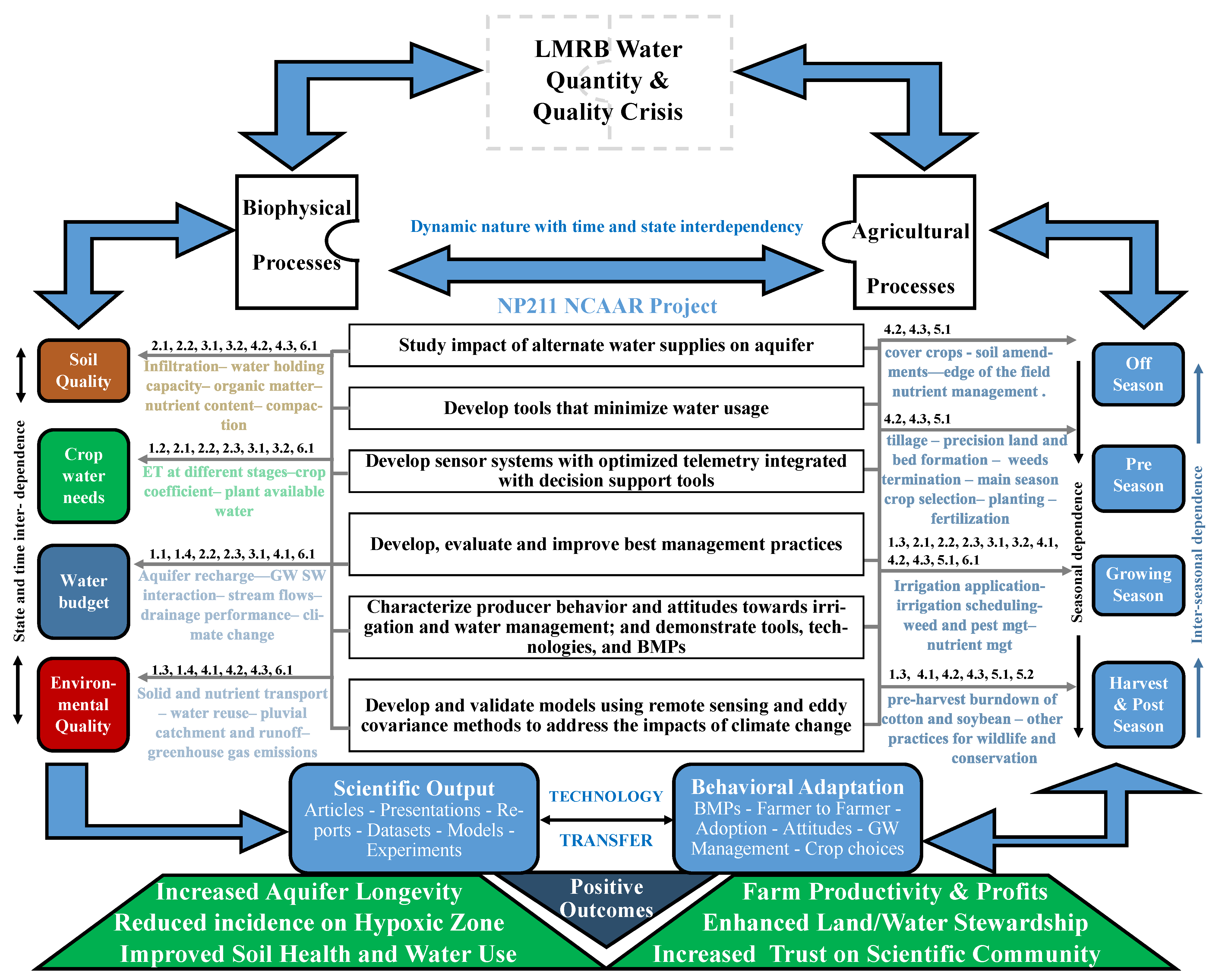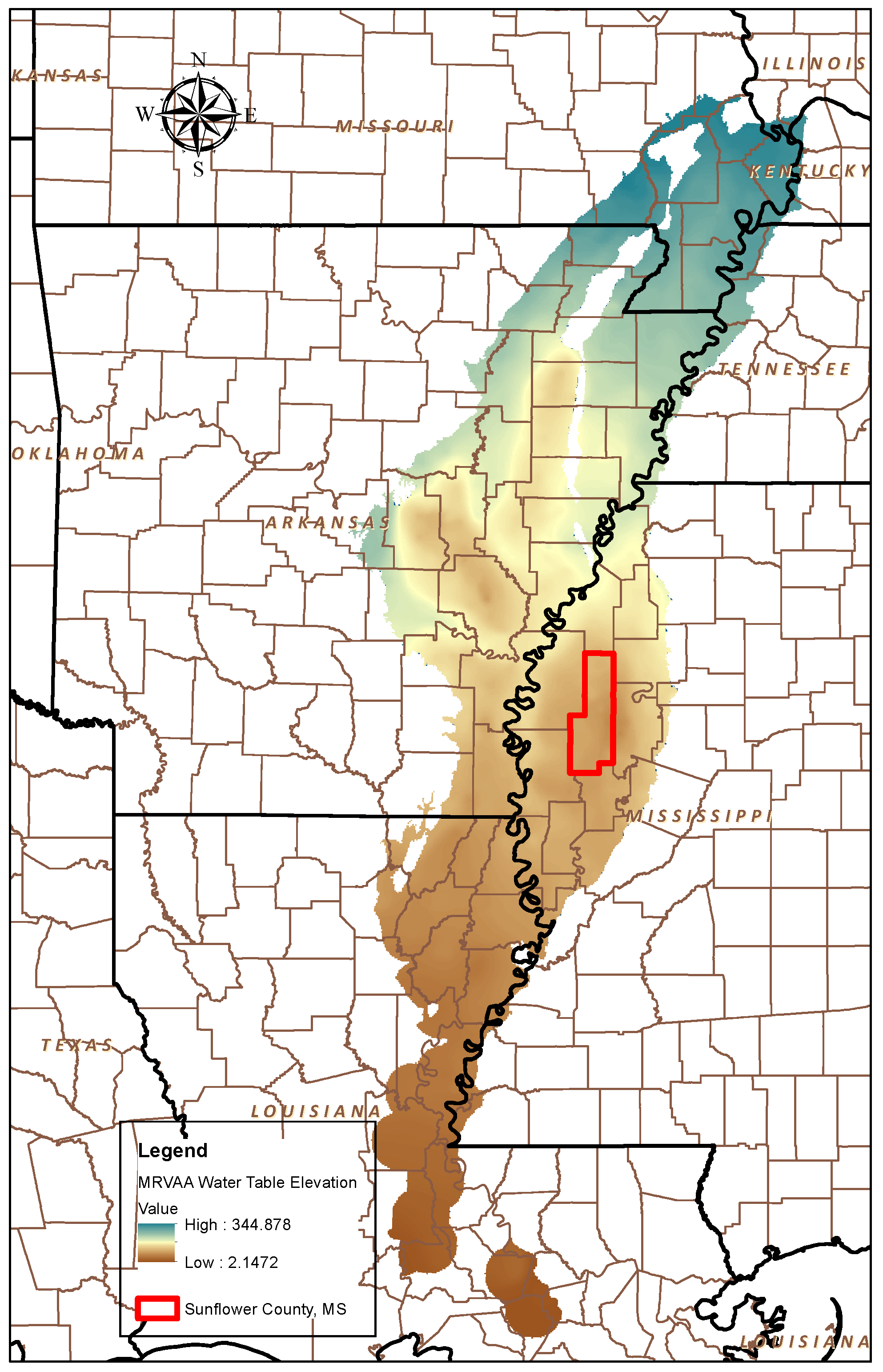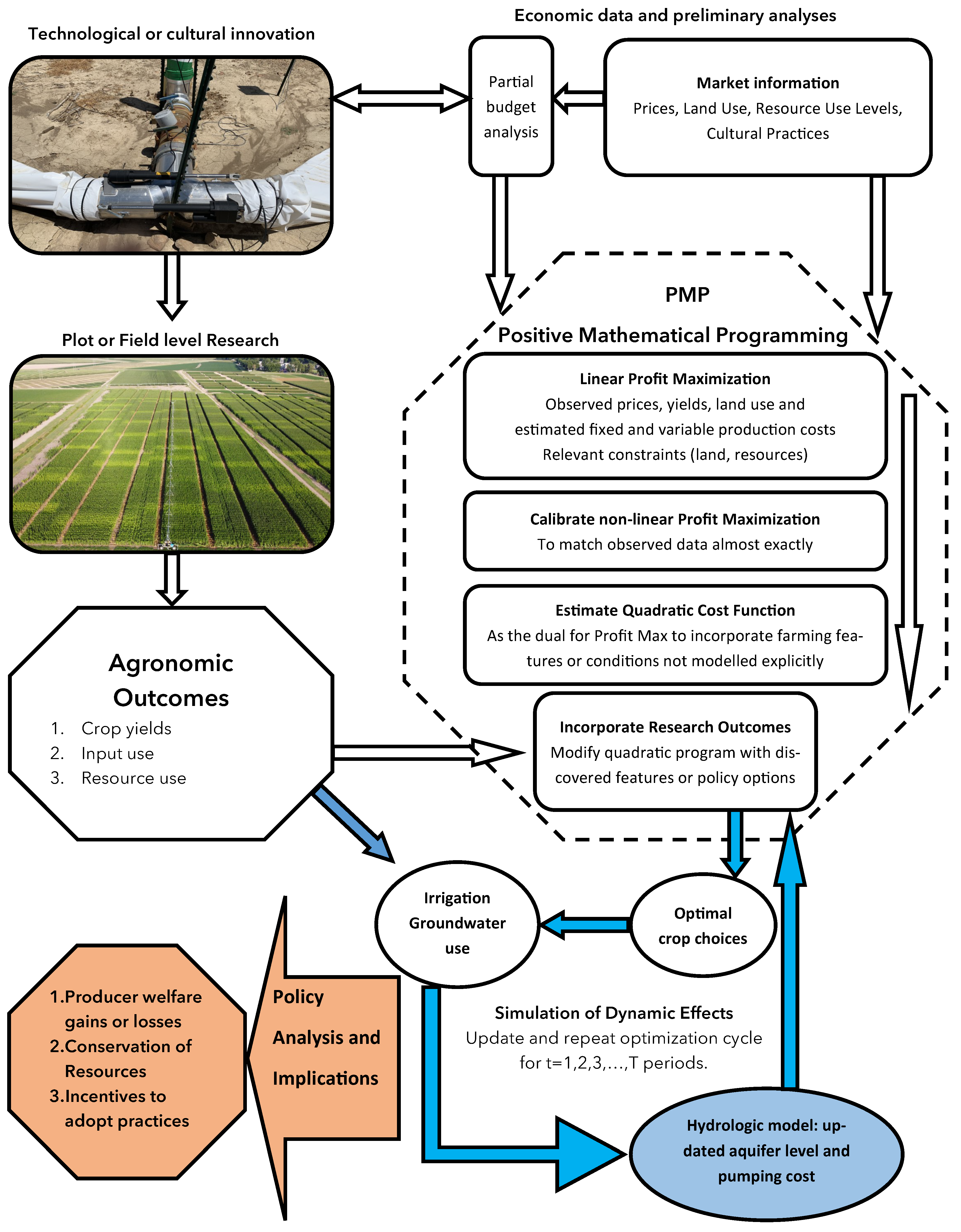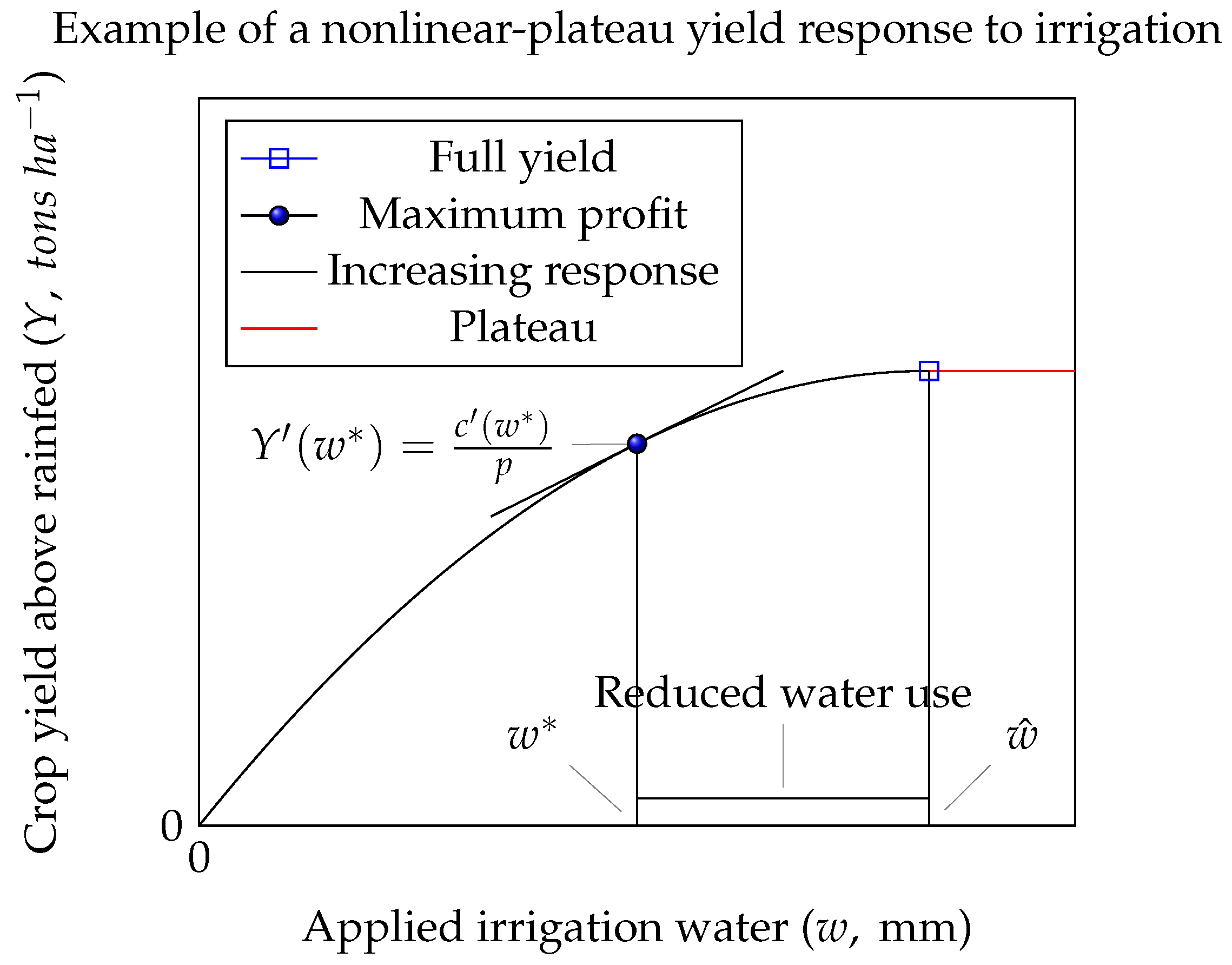Positive Mathematical Programming to Model Regional or Basin-Wide Implications of Producer Adoption of Practices Emerging from Plot-Based Research
Abstract
:1. Introduction
2. Integrating Multidisciplinary Research with Positive Mathematical Programming (PMP)
2.1. From Plot and Field-Level Research to Economic Behavior
2.2. Positive Mathematical Programming
- Use observed county-level data to formulate a constrained linear profit maximization model in which resource and input use and other resource, environmental or policy limitations are represented as constraints and the choice variable is crop acreage;
- Reformulate the problem as a nonlinear constrained optimization problem that calibrates almost exactly to the observed levels;
- Calibrate a quadratic function to capture desired production features (e.g.; water use) not included in the data or modelled explicitly;
- Implement a quadratic program including the estimated cost function as part of the objective function;
- Solve a dynamic model iteratively by updating aquifer levels based on periodic solutions to the quadratic program to produce the optimal land and water use choices.
3. Illustrative Example: Improved Soybean Dryland Yields in Sunflower County, MS
3.1. Sunflower County, MS
3.2. Results and Discussion for an Illustrative Example
4. Conclusions
Author Contributions
Funding
Institutional Review Board Statement
Informed Consent Statement
Data Availability Statement
Acknowledgments
Conflicts of Interest
Abbreviations
| ARS | USDA Agricultural Research Service |
| BMP | Best Management Practice |
| bu/a | Bushels per acre |
| C2VSim | California Central Valley Groundwater-Surface Water Simulation Model |
| CVPM | California Central Valley Production Model |
| DREC | Mississippi State University Delta Research and Extension Center |
| ECR | Early Career Researcher |
| EF | Energy efficiency |
| ESMIS | USDA Economics, Statistics and Market Information System |
| ft | Feet |
| FSA | USDA Farm Service Agency |
| GIR | Gross irrigation requirement |
| GMD3 | Kansas Groundwater Management District 3 |
| GW | Groundwater |
| IE | Irrigation water use efficiency |
| lb/a | Pounds per acre |
| LMRB | Lower Mississippi River Basin |
| LP | Linear program |
| MDEQ | Mississippi Department of Environmental Quality |
| MRVAA | Mississippi River Valley Alluvial Aquifer |
| NASS | USDA National Agricultural Statistics Service |
| NCAAR | National Center for Alluvial Aquifer Research |
| NPV | Net present value |
| NRCS | USDA Natural Resources Conservation Service |
| PMP | Positive Mathematical Programming |
| SW | Surface water |
| SWAP | California State-wide Agricultural Production economic model |
| TDH | Total dynamic head |
| USA | United States of America |
| USD | U.S. dollar |
| USDA | U.S. Department of Agriculture |
References
- Yasarer, L.M.; Taylor, J.M.; Rigby, J.R.; Locke, M.A. Trends in land use, irrigation, and streamflow alteration in the Mississippi River Alluvial Plain. Front. Environ. Sci. 2020, 8, 66. [Google Scholar] [CrossRef]
- Quintana-Ashwell, N.E.; Gholson, D.M.; Krutz, L.J.; Henry, C.G.; Cooke, T. Adoption of Water-Conserving Irrigation Practices among Row-Crop Growers in Mississippi, USA. Agronomy 2020, 10, 1083. [Google Scholar] [CrossRef]
- Quintana-Ashwell, N.E.; Anapalli, S.S.; Pinnamaneni, S.R.; Kaur, G.; Reddy, K.N.; Fisher, D.K. Profitability of twin-row planting and skip-row irrigation in a humid climate. Agron. J. 2021, in press. [Google Scholar] [CrossRef]
- Elliott, J.; Deryng, D.; Müller, C.; Frieler, K.; Konzmann, M.; Gerten, D.; Glotter, M.; Flörke, M.; Wada, Y.; Best, N.; et al. Constraints and potentials of future irrigation water availability on agricultural production under climate change. Proc. Natl. Acad. Sci. USA 2014, 111, 3239–3244. [Google Scholar] [CrossRef] [Green Version]
- Pinnamaneni, S.R.; Anapalli, S.S.; Reddy, K.N.; Fisher, D.K.; Quintana Ashwell, N.E. Assessing irrigation water use efficiency and economy of twin-row soybean in the Mississippi Delta. Agron. J. 2020, 112, 4219–4231. [Google Scholar] [CrossRef]
- Pinnamaneni, S.R.; Anapalli, S.S.; Reddy, K.N.; Fisher, D.K. Effects of irrigation and planting geometry on cotton productivity and water use efficiency. J. Cotton Sci. 2020, 24, 2–96. [Google Scholar]
- Henry, W.B.; Krutz, L.J. Water in agriculture: Improving corn production practices to minimize climate risk and optimize profitability. Curr. Clim. Chang. Rep. 2016, 2, 49–54. [Google Scholar] [CrossRef] [Green Version]
- Bryant, C.; Krutz, L.; Falconer, L.; Irby, J.; Henry, C.; Pringle, H.; Henry, M.; Roach, D.; Pickelmann, D.; Atwill, R.; et al. Irrigation water management practices that reduce water requirements for Mid-South furrow-irrigated soybean. Crop. Forage Turfgrass Manag. 2017, 3, 1–7. [Google Scholar] [CrossRef] [Green Version]
- Wood, C.; Krutz, L.; Falconer, L.; Pringle, H.; Henry, B.; Irby, T.; Orlowski, J.; Bryant, C.; Boykin, D.; Atwill, R.; et al. Surge irrigation reduces irrigation requirements for soybean on smectitic clay-textured soils. Crop. Forage Turfgrass Manag. 2017, 3, 1–6. [Google Scholar] [CrossRef]
- Spencer, G.; Krutz, L.; Falconer, L.; Henry, W.; Henry, C.; Larson, E.; Pringle, H.; Bryant, C.; Atwill, R. Irrigation Water Management Technologies for Furrow-Irrigated Corn that Decrease Water Use and Improve Yield and On-Farm Profitability. Crop. Forage Turfgrass Manag. 2019, 5, 1–8. [Google Scholar] [CrossRef] [Green Version]
- Howitt, R.E. Positive Mathematical Programming. Am. J. Agric. Econ. 1995, 77, 329–342. [Google Scholar] [CrossRef]
- Heckelei, T.; Britz, W. Models based on positive mathematical programming: State of the art and further extensions. In Proceedings of the European Association of Agricultural Economists (EAAE), Parma, Italy, 2–5 February 2005. [Google Scholar]
- Qureshi, M.E.; Whitten, S.M.; Kirby, M. A multi-period positive mathematical programming approach for assessing economic impact of drought in the Murray–Darling Basin, Australia. Econ. Model. 2014, 39, 293–304. [Google Scholar] [CrossRef]
- Garay-Armoa, P.V. The Impact of Climate Change on the Effectiveness of Water Conservation Policies in Western Kansas and the Ogallala Aquifer. Ph.D. Thesis, Kansas State University, Manhattan, KS, USA, 2015. [Google Scholar]
- Koundouri, P. Current issues in the economics of groundwater resource management. J. Econ. Surv. 2004, 18, 703–740. [Google Scholar] [CrossRef] [Green Version]
- Koundouri, P. Potential for groundwater management: Gisser-Sanchez effect reconsidered. Water Resour. Res. 2004, 40. [Google Scholar] [CrossRef] [Green Version]
- Pulido-Velazquez, M.; Andreu, J.; Sahuquillo, A.; Pulido-Velazquez, D. Hydro-economic river basin modelling: The application of a holistic surface–groundwater model to assess opportunity costs of water use in Spain. Ecol. Econ. 2008, 66, 51–65. [Google Scholar] [CrossRef]
- Clark, M.K. Effects of High Commodity Prices on Western Kansas Crop Patterns and the Ogallala Aquifer. Ph.D. Thesis, Kansas State University, Manhattan, KS, USA, 2009. [Google Scholar]
- Esteban, E.; Albiac, J. The problem of sustainable groundwater management: The case of La Mancha aquifers, Spain. Hydrogeol. J. 2012, 20, 851–863. [Google Scholar] [CrossRef]
- Lambert, L.H.; English, B.C.; Clark, C.C.; Lambert, D.M.; Menard, R.J.; Hellwinckel, C.M.; Smith, S.A.; Papanicolaou, A. Local effects of climate change on row crop production and irrigation adoption. Clim. Risk Manag. 2021, 32, 100293. [Google Scholar] [CrossRef]
- Aistrup, J.A.; Bulatewicz, T.; Kulcsar, L.J.; Peterson, J.M.; Welch, S.M.; Steward, D.R. Conserving the Ogallala Aquifer in southwestern Kansas: From the wells to people, a holistic coupled natural–human model. Hydrol. Earth Syst. Sci. 2017, 21, 6167–6183. [Google Scholar] [CrossRef] [Green Version]
- MacEwan, D.; Cayar, M.; Taghavi, A.; Mitchell, D.; Hatchett, S.; Howitt, R. Hydroeconomic modeling of sustainable groundwater management. Water Resour. Res. 2017, 53, 2384–2403. [Google Scholar] [CrossRef]
- Dale, L.L.; Dogrul, E.C.; Brush, C.F.; Kadir, T.N.; Chung, F.I.; Miller, N.L.; Vicuna, S.D. Simulating the impact of drought on California’s Central Valley hydrology, groundwater and cropping. Br. J. Environ. Clim. Chang. 2013, 3, 271. [Google Scholar] [CrossRef]
- Bulatewicz, T.; Allen, A.; Peterson, J.M.; Staggenborg, S.; Welch, S.M.; Steward, D.R. The simple script wrapper for OpenMI: Enabling interdisciplinary modeling studies. Environ. Model. Softw. 2013, 39, 283–294. [Google Scholar] [CrossRef] [Green Version]
- Sobey, A.; Townsend, N.; Metcalf, C.; Bruce, K.; Fazi, F.M. Incorporation of Early Career Researchers within multidisciplinary research at academic institutions. Res. Eval. 2013, 22, 169–178. [Google Scholar] [CrossRef] [Green Version]
- Parson, E.A. Integrated assessment and environmental policy making: In pursuit of usefulness. Energy Policy 1995, 23, 463–475. [Google Scholar] [CrossRef]
- Rotmans, J.; Van Asselt, M. Integrated assessment: A growing child on its way to maturity. Clim. Chang. 1996, 34, 327–336. [Google Scholar] [CrossRef]
- Adams, K.; Kovacs, K. The adoption rate of efficient irrigation practices and the consequences for aquifer depletion and further adoption. J. Hydrol. 2019, 571, 244–253. [Google Scholar] [CrossRef]
- Pindyck, R.; Rubinfeld, D. Microeconomics, 7th ed.; Prentice Hall: Upper Saddle River, NJ, USA, 2009. [Google Scholar]
- DeLaune, P.; Mubvumba, P.; Ale, S.; Kimura, E. Impact of no-till, cover crop, and irrigation on Cotton yield. Agric. Water Manag. 2020, 232, 106038. [Google Scholar] [CrossRef]
- Currie, R.S.; Klocke, N.L. Impact of a terminated wheat cover crop in irrigated corn on atrazine rates and water use efficiency. Weed Sci. 2005, 53, 709–716. [Google Scholar] [CrossRef]
- Martin, D.L.; Watts, D.G.; Gilley, J.R. Model and production function for irrigation management. J. Irrig. Drain. Eng. 1984, 110, 149–164. [Google Scholar] [CrossRef] [Green Version]
- Barlow, J.R.; Clark, B.R. Simulation of Water-Use Conservation Scenarios for the Mississippi Delta Using an Existing Regional Groundwater Flow Model; US Department of the Interior, US Geological Survey: Reston, VA, USA, 2011.
- Bryant, P. Mississippi Governor Executive Order 1341. 2014. Available online: https://www.sos.ms.gov/communications-publications/executive-orders (accessed on 22 October 2021).
- Brozović, N.; Sunding, D.L.; Zilberman, D. On the spatial nature of the groundwater pumping externality. Resour. Energy Econ. 2010, 32, 154–164. [Google Scholar] [CrossRef] [Green Version]
- USDA-NASS. Mississippi Soybean County Estimates; National Agricultural Statistics Service, United States Department of Agriculture: Washington, DC, USA, 2020.
- Tang, Q.; Feng, G.; Fisher, D.; Zhang, H.; Ouyang, Y.; Adeli, A.; Jenkins, J. Rain water deficit and irrigation demand of major row crops in the Mississippi Delta. Trans. ASABE 2018, 61, 927–935. [Google Scholar] [CrossRef]




| Component | Parameter | Value |
|---|---|---|
| Aquifer | Surface elevation (FASL) | 118 |
| Initial water table elev. (FASL) | 77.91 | |
| Aquifer base elevation (FASL) | −18.49 | |
| Net recharge (R, acre-ft) | 231,802 | |
| Acres x specific yield () | 89,344 | |
| Crop mix | Soybean share | 77% |
| Corn share | 12% | |
| Rice share | 4% | |
| Cotton share | 7% | |
| Irrigation | Application efficiency () | 0.54 |
| Discount | Rate | 0.03 |
| Crop | Irrigation | Min. | Full-Water | Average | Water Use | Cost | Acres |
|---|---|---|---|---|---|---|---|
| Yield | Yield | Yield | (ft/acre) | (acre) | |||
| Corn | Furrow | 114 bu/a | 280 bu/a | 220 bu/a | 0.83 | 680 | 27,857 |
| Dryland | 170 bu/a | 585 | 8343 | ||||
| Soybean | Furrow | 26 bu/a | 82 bu/a | 77 bu/a | 1.16 | 498 | 158,144 |
| Dryland | 57 bu/a | 404 | 76,356 | ||||
| Cotton | Furrow | 1090 lb/a | 1800 lb/a | 1479 lb/a | 0.5 | 924 | 16,958 |
| Dryland | 1261 lb/a | 833 | 3747 | ||||
| Rice | Flood | 99 bu/a | 253 bu/a | 228 bu/a | 2.7 | 817 | 13,830 |
| Crop | Irrigation | Acres | Water Use (acre-ft) | Profits (year) | |||
|---|---|---|---|---|---|---|---|
| Year 1 | Year 20 | Year 1 | Year 20 | Year 1 | Year 20 | ||
| Corn/calib. | Furrow | 27,873 | 27,620 | 23,135 | 22,789 | 22.8M | 22.5M |
| Dryland | 8343 | 8343 | 0 | 0 | 5.3M | 5.3M | |
| Corn/shock | Furrow | 23,752 | 23,775 | 19,715 | 19,757 | 19.4M | 19.4M |
| Dryland | 4995 | 4971 | 0 | 0 | 3.19M | 3.18M | |
| Soybean/calib. | Furrow | 158,142 | 157,490 | 184,077 | 182,783 | 117.2M | 116.6M |
| Dryland | 76,356 | 76,356 | 0 | 0 | 43.8M | 43.8M | |
| Soybean/shock | Furrow | 144,668 | 144,707 | 168,393 | 168,536 | 107.2M | 107.3M |
| Dryland | 109,167 | 109,094 | 0 | 0 | 83.2M | 83.2M | |
| Cotton/calib. | Furrow | 16,913 | 16,592 | 8457 | 8235 | 16.4M | 16.1M |
| Dryland | 3747 | 5110 | 0 | 0 | 3.1M | 4.3M | |
| Cotton/shock | Furrow | 9811 | 9827 | 4905 | 4920 | 9.5M | 9.5M |
| Dryland | ≈0 | ≈0 | 0 | 0 | 0 | 0 | |
| Rice/calib. | Flood | 13,859 | 13,723 | 37,420 | 36,799 | 14.9M | 14.8M |
| Rice/shock | Flood | 12,841 | 12,861 | 34,670 | 34,772 | 13.9M | 13.9M |
| Scenario | Net Present Value | Aggregate | Change in |
|---|---|---|---|
| of Farm Profits | Water Use (acre-ft) | Aquifer Level (ft) | |
| Calibrated scenario | billion | 5 million | 4.5 ft decrease |
| Yield shock scenario | billion | 4.6 million | 0.9 ft increase |
Publisher’s Note: MDPI stays neutral with regard to jurisdictional claims in published maps and institutional affiliations. |
© 2021 by the authors. Licensee MDPI, Basel, Switzerland. This article is an open access article distributed under the terms and conditions of the Creative Commons Attribution (CC BY) license (https://creativecommons.org/licenses/by/4.0/).
Share and Cite
Quintana-Ashwell, N.; Kaur, G.; Singh, G.; Gholson, D.; Delhom, C.; Krutz, L.J.; Hegde, S. Positive Mathematical Programming to Model Regional or Basin-Wide Implications of Producer Adoption of Practices Emerging from Plot-Based Research. Agronomy 2021, 11, 2204. https://doi.org/10.3390/agronomy11112204
Quintana-Ashwell N, Kaur G, Singh G, Gholson D, Delhom C, Krutz LJ, Hegde S. Positive Mathematical Programming to Model Regional or Basin-Wide Implications of Producer Adoption of Practices Emerging from Plot-Based Research. Agronomy. 2021; 11(11):2204. https://doi.org/10.3390/agronomy11112204
Chicago/Turabian StyleQuintana-Ashwell, Nicolas, Gurpreet Kaur, Gurbir Singh, Drew Gholson, Christopher Delhom, L. Jason Krutz, and Shraddha Hegde. 2021. "Positive Mathematical Programming to Model Regional or Basin-Wide Implications of Producer Adoption of Practices Emerging from Plot-Based Research" Agronomy 11, no. 11: 2204. https://doi.org/10.3390/agronomy11112204
APA StyleQuintana-Ashwell, N., Kaur, G., Singh, G., Gholson, D., Delhom, C., Krutz, L. J., & Hegde, S. (2021). Positive Mathematical Programming to Model Regional or Basin-Wide Implications of Producer Adoption of Practices Emerging from Plot-Based Research. Agronomy, 11(11), 2204. https://doi.org/10.3390/agronomy11112204







